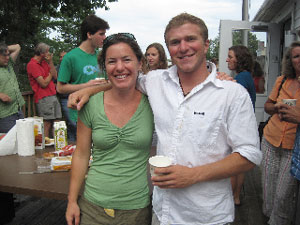

 | |||||||||||
|
|
Journals 2009/2010Jennifer Emblidge
August 13, 2009 Today I had the opportunity to visit the Bigelow Marine Lab in Boothbay Harbor, Maine. This is where Rick Wahle's office and year-round lab are stationed. Rick Wahle and David Fields, another Bigelow researcher, hosted the first Research Experience for Undergraduates program at the lab this summer. Bigelow Marine Labs hosted 8 undergraduate students from around the nation. Their stay lasted eight weeks during the months of July and August this summer. These students worked with a Bigelow researcher and designed their own summer research project. Today the REU students presented their work and competed for a $1,000 travel award.
Before the presentations got underway, Charlene gave me a tour of the marine facilities at Bigelow. Everyone we passed during the tour way very friendly and welcoming. It looks like a fun place to work! Next, she took me over to the neighboring Division of Marine Fisheries building and showed me areas where she previously worked. My favorite part was the wet lab where there was large tanks containing creatures like dogfish, skates, wolf fish and gigantic blue lobsters. This building also houses the state aquarium. The Wahle lab hosted an REU student named Noah Oppenhein this summer. Noah is going into his junior year studying Biology at Reed College in Portland, Oregon. This summer Noah looked at the predation on the American lobster in the Gulf of Maine. Noah decided to examine this issue because not much is known about lobster predation during the night hours. However, lobsters are nocturnal animals and do their foraging at night. Lobsters are preyed on by crabs and fish species like cod, bass, sculpin and toadfish. Over the past 20 years, the ground fish population in Maine has been depleted by over fishing. By decreasing the population size of the top predator in the lobster food web, the lobster population has increased in size. Noah ran his nighttime studies by using video monitoring coupled with the tethering of lobsters. This type of study is unique because of previous limits in technology. Noah, with the help of a local engineer, set up a system using a LED light to illuminate the area where the lobster is tethered. This way, with light, real-time video can be taken of lobster predation during the nighttime. While SCUBA diving, Noah placed lobsters that were tethered, or tied, to a grid in three coastal locations. Noah monitored the tethered lobsters using the video cameras that he set up above the lobsters. He found that during the nighttime lobster predation increased. Around 90 percent of this predation was by another American lobster. During the day time, only about 10 percent of lobsters are preyed upon by other lobsters. In conclusion, Noah's video studies revealed an abundance of nighttime lobster cannibalism. This may be caused by the fact that lobsters are encountering each other more during the nighttime due to the fact that their population size has increased because of the loss of their fish predators. After the completion of Noah's presentation, I asked him what he liked the most about his REU in the Wahle lab. He replied that he enjoyed being immersed in such a hardworking lab. From what I have seen so far, the Wahle lab has really shown him what being a scientist is all about. The rest of the REU presentations were amazing. I was very impressed with the quality of undergraduate research that went on this summer.
|
||||||||||

